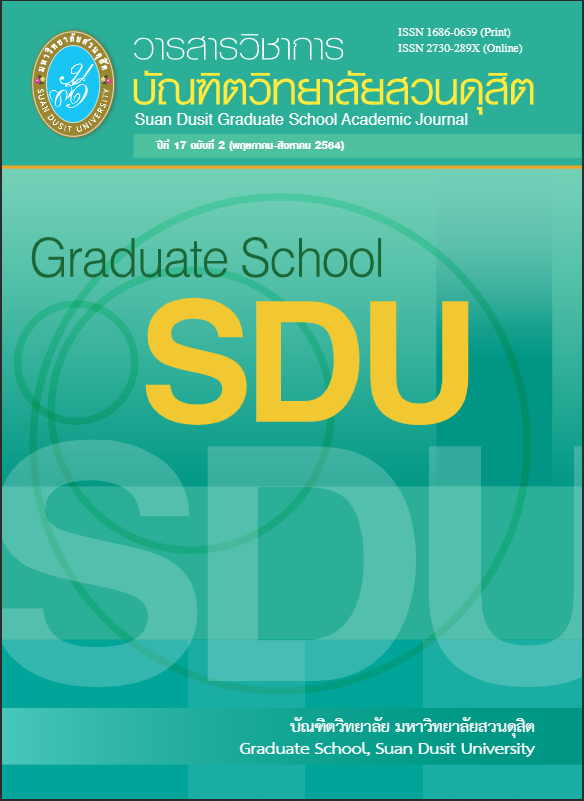The Comparative Study of the Appearance of Latent Fingerprint on Leather by Using Superglue Method
Keywords:
Latent Fingerprint, Leather, SuperglueAbstract
The research aimed to study the appearance of latent fingerprints on leather by using Superglue method at room temperature as well as comparing the appearance of latent fingerprints on leather, classified by differences in time and types of leathers. This research was an experimental research. The experiment on collecting latent fingerprints by Superglue method was carried out with four types of leather, which consisted of top grain leather, suede, PU leather and patent leather. The experiment was also conducted in eight different times which were immediately after fingerprinting, 3 hours, 6 hours, 12 hours, 1 day, 3 days, 5 days and 7 days. Then, latent fingerprints were verified by counting the number of important points with the Automated Fingerprint Identification System which were used for the analysis. It was noted that quality of latent fingerprint on leather was significantly different at the level of 0.05 (F = 11.586, Sig = 0.000). When considering the quality of latent fingerprint on each leather, it was found that latent fingerprint appearing on top grain leather was the best quality. For time differences in the appearance of latent fingerprints on leather, it was found that it was insignificantly different in the appearance of latent fingerprints on leather.
References
จิตรกร คอวนิช. (2547). การศึกษาสภาพและปัญหาการส่งออกในธุรกิจอุตสาหกรรมกระเป๋าหนัง. วิทยานิพนธ์ปริญญามหาบัณฑิต สาขาวิชาธุรกิจอุตสาหกรรม บัณฑิตวิทยาลัย สถาบันเทคโนโลยีพระจอมเกล้าพระนครเหนือ.
ชนินทร์ จิตต์โกมุท. (2551). ความรู้เรื่องเครื่องหนัง. กรุงเทพฯ: จุฬาลงกรณ์มหาวิทยาลัย.
ชวลิต ศรีทับทิม และประภาศรี โพธิ์ทอง. (2553). รายงานการวิจัยเรื่อง การสร้างหลักสูตรระยะสั้นการทำผลิตภัณฑ์หนัง. คณะศิลปกรรมศาสตร์ มหาวิทยาลัยเทคโนโลยีราชมงคลธัญบุรี
ณุชชนา สวัสดี. (2552). วิธีปฏิบัติในการรักษาสภาพของสถานที่เกิดเหตุในคดีฆาตกรรม. วิทยานิพนธ์ปริญญาวิทยาศาสตรมหาบัณฑิต (สาธารณสุขศาสตร์) สาขาวิชาเอกบริหารกฎหมายการแพทย์และสาธารณสุข บัณฑิตวิทยาลัย มหาวิทยาลัยมหิดล.
ทวีทรัพย์ เล็กประดิษฐ์. (2553). การพัฒนาตู้อบสำหรับใช้สาร Cyanoacrylate เพื่อหารอยลายนิ้วมือแฝง. วิทยานิพนธ์ปริญญาวิทยาศาสตรมหาบัณฑิต สาขานิติวิทยาศาสตร์ บัณฑิตวิทยาลัย มหาวิทยาลัย ศิลปากร.
นฤพล บำรุงเรือน. (2558). ความมีชีวิตในผลิตภัณฑ์เครื่องหนัง. ศิลปนิพนธ์ปริญญาบัณฑิต สาขาวิชา ทัศนศิลป์ คณะจิตรกรรม ประติมากรรมและภาพพิมพ์ มหาวิทยาลัยศิลปากร.
รุ้งรวีย์ ทองธรรมชาติ (2561). การพัฒนาผงฝุ่นจากแกลบดำในการตรวจหารอยลายนิ้วมือแฝงบนพื้นผิว ที่แตกต่างกัน. วิทยานิพนธ์ปริญญาวิทยาศาสตรมหาบัณฑิต สาขานิติวิทยาศาสตร์ คณะ นิติวิทยาศาสตร์ โรงเรียนนายร้อยตำรวจ.
สกลกฤษณ์เอกจักรวาล. (2554). การเปรียบเทียบระยะเวลาที่สามารถตรวจพบรอยลายนิ้วมือแฝงบนปลอกกระสุนปืนออโตเมติกประเภททองเหลือง ขนาด 9 และ 11 มิลลิเมตร. วิทยานิพนธ์ปริญญา วิทยาศาสตรมหาบัณฑิต สาขานิติวิทยาศาสตร์ บัณฑิตวิทยาลัย มหาวิทยาลัยศิลปากร.
สมจารี คันธชาติกุล. (2558). การศึกษาหาระยะเวลาการคงอยู่ลายนิ้วมือแฝงบนพลาสติก 3 ประเภทโดยใช้วิธีซุปเปอร์กลูในสภาวะวดล้อมที่แตกต่างกัน. ใน รายงานการประชุมวิชาการและนำเสนอผลการวิจัย ระดับชาติและนานาชาติ ครั้งที่ 6 กลุ่มระดับชาติด้านวิทยาศาสตร์. กรุงเทพฯ: มหาวิทยาลัยราชภัฏสวนสุนันทา.
สุภาพร ยิ่งยง. (2554). การเปรียบเทียบวิธีการตรวจหาลายนิ้วมือแฝงบนผลไม้ด้วยวิธีปัดผงฝุ่นและ วิธีซุปเปอร์กลู.วิทยานิพนธ์ปริญญาวิทยาศาสตรมหาบัณฑิต สาขานิติวิทยาศาสตร์ บัณฑิตวิทยาลัยมหาวิทยาลัยศิลปากร.
อนุชา ชูวงษ์. (2549). ออกแบบเครื่องทดสอบวัสดุหนัง เพื่อความเหมาะสมกับการออกแบบผลิตภัณฑ์. วิทยานิพนธ์ปริญญามหาบัณฑิต สาขาวิศวกรรมการผลิต บัณฑิตวิทยาลัย สถาบันเทคโนโลยีพระจอมเกล้าพระนครเหนือ.
อรรถพล แช่มสุวรรณวงศ์ และคณะ. (2544). นิติวิทยาศาสตร์ 2 เพื่อการสืบสวนสอบสวน. กรุงเทพฯ: ดาวฤกษ์.
The Leather Dictionary. (2020). Patent leather. [Online]. Available: https://www.leatherdictionary.com/index.php/Patent_leather [2020, April 1].
Rory P. Downham et al. (2015). Feasibility Studies of Fingermark Visualization on Leather and Artificial Leather. Journal of Forensic Identification, 65 (2): 138-159.
Xiaochun Zheng et al. (2017). The effectiveness and practicality of using simultaneous superglue & iodine fuming method for fingermark development on 'low yield' leather surfaces: A feasibility study. Forensic Science International, 281: 152-160.
Downloads
Published
How to Cite
Issue
Section
License
Copyright (c) 2021 Suan Dusit Graduate School Acadamic Journal

This work is licensed under a Creative Commons Attribution-NonCommercial-NoDerivatives 4.0 International License.






